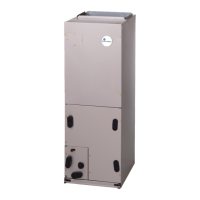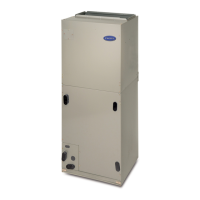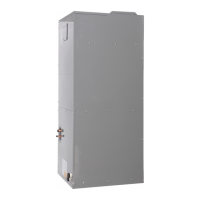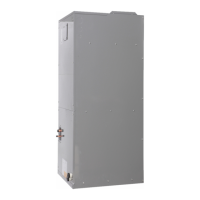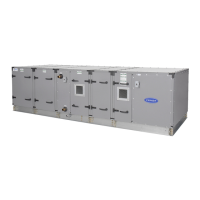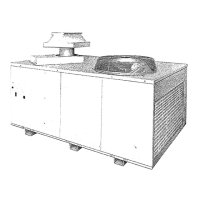53
Table 23 — LED Codes
Staged Heat
If the ECAT is below ECAT heating setpoint, first stage heating
will be initiated. If the leaving air temperature (LAT) is below
the LAT setpoint (default is 70°F), the second stage of heating
will be initiated.
When system is powered up 24 VAC will be applied to the igni-
tion control (IC) terminals 24VAC / R and to the Timer Relay
Control (TR1). The ignition control will reset, perform a self
check routine, initiate full time flame sensing, flash the diagnostic
LED for up to four seconds and enter the thermostat scan standby
state. The amber light on the TR1 will be lit indicating it is in the
ready position.
See Fig. 84-87 for staged heat wiring diagram and typical horizon-
tal and vertical installation.
CALL FOR HEAT
1. Controller (first stage or first and second stage) closes on call
for heat.
2. 24 VAC to is supplied to IC terminal TH, provided limit
switch is in closed position.
3. The control will check that pressure switch contacts are open
(IC terminal PSW is not powered).
4. Combustion blower is then energized at high speed.
5. When the Air Switch (APS1) closes, a 15-second pre-purge
period begins.
6. At end of pre-purge period, the spark commences and the first
and second stage gas valves are energized for the trial for
ignition period.
7. Burners ignite and cross light, operating at maximum input
rate (manifold pressure 3.5 in. wg).
8. The TR1 is powered (terminal 7) simultaneously (SR LED
lit) and begins timing a 90-second warm-up period while
maintaining the combustion blower at high speed (FR LED
lit). The TR1 will maintain this mode of operation, regardless
of status of thermostat second stage.
9. When flame is detected by flame sensor, the spark is shut-off
immediately and gas valves and combustion blower remain
energized.
LED CODE SYSTEM DESCRIPTION ACTIONS
None
No Power to
T1
On call for heat nothing happens.
1. Check for open fuse or circuit breaker.
2. Check for poor wiring connection.
3. Check for failed 24V transformer.
Steady On No Operation
24 VAC across terminal 24 VAC/V2-Gnd when
thermostat calling for heat.
1. System fault. Repeated lockouts (5) during continuous call
for heat.
2. Check input voltage and inlet gas pressure during system
operation.
3. Check for condensate or blockage in air tube or pressure
switch.
4. Check for blocked vent condition or obstruction in heat
exchanger tube.
5. If sequencer is used check delay time setting.
6. Control fault. Replace control.
None
Open Limit
Switch
Thermostat call for heat. No power across
terminals V1/V2 on control.
1. Check for proper operation of circulating air supply system
and for air filter blockage.
2. Check manifold pressure when limit cools and closes.
Natural gas 3.5 in. wg / LP gas 10.0 in. wg
Low combustion blower air output. Flue gas temp exceeds
550 F. Inspect for debris accumulation, proper wheel attach-
ment, proper voltage to blower.
1 Flash Air Flow Fault
Pressure switch contacts in closed position for 30
seconds with no output to combustion blower.
Remains in this mode with combustion blower off.
1. Check for short in wiring to pressure switch.
2. Check pressure switch for closed contacts (with leads dis-
connected).
3. Replace pressure switch.
Open pressure switch or flame rollout switch when
inducer (IND terminal) is energized. If switch
remains open for more than 30 seconds after
combustion blower is energized, control will remain
in this mode with IND terminal (blower) energized.
1. Failed combustion blower.
2. Check connections and air tube from draft inducer to air
switch for leaks.
3. Check rollout switch manual reset - depress reset.
4. Check supply tube from draft inducer housing to pressure
switches for condensate - drain line and reconnect.
5. Check pressure switch for condensate accumulation.
6. Replace pressure switch.
2 Flash Flame Fault
Flame sense failure/flame present with no call for
heat.
1. Check for voltage to gas valve with thermostat in off posi-
tion. Valve should not be powered.
2. If valve is not energized, check for gas flow (manifold pres-
sure reading greater than 0). If gas flow, turn off main shut-
off valve or replace gas valve.
3 Flash Lockout
Failure to light and or carryover, loss of flame or
flame signal during ignition or operating cycle.
Control will initiate up to 3 igntion re-trials before
lockout.
1. Verify gas supply available and operation of gas valve -
manifold pressure at start of ignition cycle. Check for power
to valve terminals LO and COM while spark is energized.
2. Is spark present? If not check igniter for debris between
electrodes, cracked ceramic and check ignition wire for
short to ground.
3. Check flame sensor wiring connections to electrode and
control and for any abrasions.
4. Check for cracked ceramic on flame sensor or grounded
sensor rod.
5. Verify that ample air supply and proper venting of flue gases
occurs during operating cycle.
6. Check for circulating air leaks into burner compartment
during operation.
7. Check for re-circulation of flue gases into combustion air
supply.
8. If all conditions satisfactory - replace ignition control.

